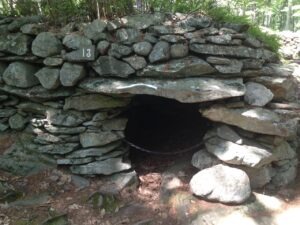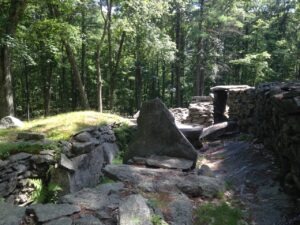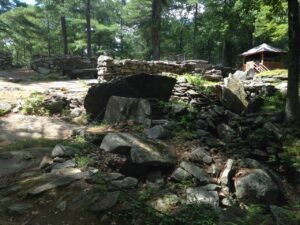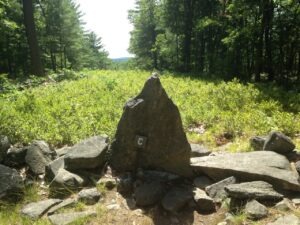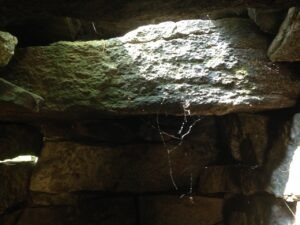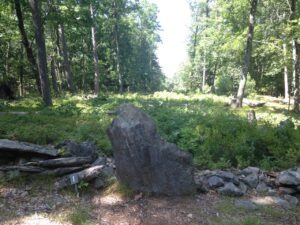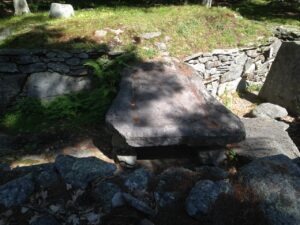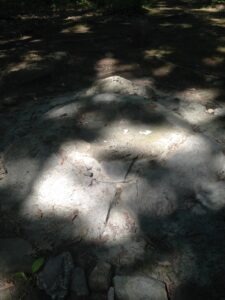Nestled in the woods of Salem, NH is a site that’s filled with mysterious stonework. There are long-running walls and secluded chambers, as well as prominent standing stones. There’s even a large grooved slab that some say was a sacrificial table! Today this place is known as America’s Stonehenge, though it was formerly called Mystery Hill. The origin of these structures has been debated for years. Do they date from the 19th century or are they ancient?
When visiting America’s Stonehenge, there is a trail to follow which leads to various points of interest. Stonewalls spread out over the area and every so often you’ll see distinctive pointed stones that are about 4 feet tall. These standing stones align with astronomical events, such as the summer as winter solstices. There are a number of stone chambers, many around a central stone outcropping. In this area is a stone referred to as a sacrificial table – it’s a large horizontal slab with drainage grooves cut into it. Beneath the table sits what’s known as the Oracle Chamber. It’s stated that a speaking tube connects from the chamber to under the table to give the effect that the table was talking.
As is sometimes stated in articles about America’s Stonehenge, the first written reference to the structures can be found in Edgar Gilbert’s History of Salem, N.H., published in 1907:
Jonathan Pattee’s Cave. He had a house in these woods 70 yrs. ago; took the town paupers before the town farm was bought. This is a wild but beautiful spot among rough boulders and soft pines, about which the most wierd [sic] and fantastic tale might be woven. There are several caves still intact, which the owner used for storage purposes.
So, at one point in the past, the structures were named after Jonathan Pattee. He was the owner of the property from 1801 until his death in 1849. (Technically, his wife, Betsey, was sole owner for part of that period to insulate the estate from a lawsuit with the town.) Pattee was a shoemaker and the land had been in his family since 1734. While some assert that Jonathan Pattee built the structures, others contend that he actually sold some of the stones. Still, it may have been Jonathan’s son, Seth J. M. Pattee who removed stones after he inherited the land. The property remained in the Pattee family until 1863 (with a return to Pattee hands from 1902-1927).
Another prominent figure in the history of the site is William Goodwin, a retired insurance executive and amateur archeologist who purchased the property in 1937. He came to believe that the structures were created by Irish monks (known as the Culdees) in AD 1000. Some articles assert that Goodwin rearranged many of the stones in an attempt to restore the site to what he believed was the original layout, and thus made subsequent archeological analysis very difficult. However, modern researcher Mary Gage states that the changes made were minor, given comparisons to pre-restoration photographs. Goodwin wrote a book about his theories and continued researching the site until he passed away in 1950.
Robert Stone, an electronic engineer, began leasing it in 1956 and opened it to the public as Mystery Hill Caves two years later. He subsequently purchased the entire site in 1965. In 1970, Stone photographed a winter solstice alignment over one of the stones and, ultimately, numerous other astronomically positioned stones were found. The name of the site was changed to America’s Stonehenge in 1982, an allusion to the alignments of Stonehenge in England.
Since its time opening to the public, other theories have been presented. One that’s often discussed came from Harvard professor Dr. Barry Fell. In 1976, Dr. Fell published a book called America BC, in which he stated that inscriptions at the site were written in the ancient languages of Ogham (Irish), Phoenician, and Iberian Punic. However, the book received harsh criticism from mainstream archeologists who countered that the inscriptions looked like scrapes from plows. Many also point out that Dr. Fell’s qualifications were actually in marine biology.
A major piece of evidence is carbon dating that was done on charcoal uncovered at the site. The results showed it was approx. 3,500 years old. While some use this number as an indicator of the potential age of the structures, mainstream archeologists argue that the charcoal is only evidence of fire, not human activity.
Mary Gage, who has written books about America’s Stonehenge and maintains an extensive website, believes that Native Americans (the Abenaki) built the structures over the course of generations. She asserts that initial work began 3,000 years ago and, as part of her evidence, cites Native American pottery shards found on the property that were dated to that time period. This also ties in with charcoal carbon dating. Additionally, she notes that the tool markings on the stones indicate that that they were fashioned with stone tools, rather than metal. Mary Gage is of the opinion that it was a sacred site where ceremonies were held.
The mainstream archeological viewpoint is that the structures were built hundreds, as opposed to thousands, of years ago. They often cite research done in the 1950s by Gary Vescelius, who concluded the chambers were likely made in the 19th century. As such, the academic perspective seems to be that the builder was Jonathan Pattee, with the site being further modified by Goodwin. In terms of the sacrificial table, skeptics argue it’s either a colonial-era lye stone or cider press. As far as the astronomical alignments, at least some archeologists have stated that the stone positions are just coincidence.
Today, America’s Stonehenge is owned by Robert Stone’s son, Dennis Stone. With the purchase of admission, you can freely walk the trail and explore the area. They have a free smartphone app that provides details about their interpretations of the structures. (I used the app when I visited some years ago.) There’s off-street parking, a gift shop, winter snowshoeing, and there are also alpacas! You’ll want to check the official website for current hours and special events. Additionally, it seems they normally have extended hours on days of astrological significance, so visitors can see the alignments.
It’s hard to know if there will ever be a full consensus on the origins of America’s Stonehenge. Various books have been written on the topic and my post here just scratches the surface. Whatever the truth is, I found it to be a wonderful place to visit. A comfortable trail meandering through nature and mysterious stones is hard to pass up. Overall, this site presents an enduring mystery and I found it well worth visiting.
Location
105 Haverhill Road
Salem, NH 03079
Official site: stonehengeusa.com
Sources
Atkinson, Jay. “America’s Stonehenge: A Classic Whodunit and Whydunit.” The New York Times, December 10, 2009. https://www.nytimes.com/2009/12/11/travel/escapes/11stonehenge.html.
Baker, Frank. “Does N.H. Stonehenge Predate Columbus?” Los Angeles Times, June 7, 1992. https://www.latimes.com/archives/la-xpm-1992-06-07-mn-182-story.html.
Breen, Tom. “NH’s ‘Stonehenge,’ prehistoric or not, is an enduring puzzle.” Journal Inquirer, December 15, 2018. https://www.journalinquirer.com/newsletters/nh-s-stonehenge-prehistoric-or-not-is-an-enduring-puzzle/article_f1c08280-ffc9-11e8-a7ef-37d139ae5eb0.html.
Date, Terry. “Sacred site: Shining a light on America’s Stonehenge.” The Eagle-Tribune, May 8, 2022. https://www.eagletribune.com/news/new_hampshire/sacred-site-shining-a-light-on-americas-stonehenge/article_0526ccae-ce4c-11ec-b281-b701ebdc46ba.html.
George, Stephen C. “America’s Stonehenge: Inside the Rocky History of New Hampshire’s Mystery Hill.” Discover, February 3, 2021. https://www.discovermagazine.com/planet-earth/americas-stonehenge-inside-the-rocky-history-of-new-hampshires-mystery-hill.
Gilbert, Edgar. History of Salem, N.H. Concord, NH: Rumford Printing Company, 1907. https://archive.org/details/historyofsalemnh00gilb/page/n9/mode/2up.
Goudsward, David and Robert E. Stone. America’s Stonehenge: The Mystery Hill Story. Boston: Branden Books, 2003.
New Hampshire Public Radio. “Archeological Treasures In Southern New Hampshire: America’s Stonehenge.” NHPR, July 29, 2014. https://www.nhpr.org/post/archeological-treasures-southern-new-hampshire-americas-stonehenge.
Selbert, Pamela. “America’s Stonehenge.” Chicago Tribune, December 10, 2000. https://www.chicagotribune.com/news/ct-xpm-2000-12-10-0012090178-story.html.
Stevens, Rik. “America’s Stonehenge: New Hampshire rocks history or hoax?” Chicago Tribune, September 20, 2015. https://www.chicagotribune.com/nation-world/sns-bc-us–americas-stonehenge-20150920-story.html.
Wright, Karen. “Light Elements: Yankee Doodle Druid.” Discover, February 1, 1998. https://www.discovermagazine.com/planet-earth/light-elements-yankee-doodle-druid.
Written by A. P. Sylvia


